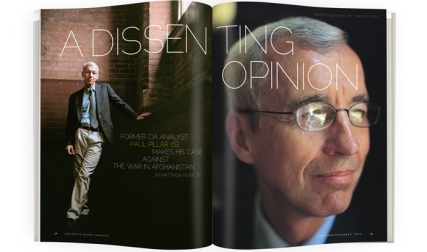In 1975, in the winter term of their first year in Hanover, roommates Paul Krupka ’79 and Mark Lewis ’79 got together with next-door neighbors Thomas Carlson ’79 and Douglas Furth ’79 and hatched a plan.
By cramming all four of their beds into one dorm room, they could free up the other for Led Zeppelin. Well, not literally Jimmy Page and his double-neck Gibson but lots of his music, played loudly.
“My stereo had a good amount of power, so we hung my speakers from the ceiling with all my albums lined up underneath,” says Krupka, who’s now an engineering consultant near San Francisco. “It was nice to have a space to kick back.”
What made the makeover feasible (even while violating College housing rules) was that the two rooms shared a connecting door, like the kind seen in motel rooms, because that’s exactly where they lived: in the Lodge, a 39-room former motor inn on Lebanon Street that after a 14-year run was converted into a dorm right before Krupka showed up. As its first student residents unpacked their bags it was clear that the College hadn’t done much to prep the boxy, flat-roofed structure, which was clad in redwood and boasted a drive-through window at a corner, for its new residential function. At least it was a far cry from the Hitchcocks of the world.
Parked cars encircled the building. Wall-to-wall carpeting covered the floors. Counters shone with Formica. Ice machines rumbled in stairwells. And in an era when the campus was still fairly compact, the location, tucked behind the Hop on the outskirts of town, wasn’t exactly central.
“I was about as close to West Leb as any dorm on campus could be,” says Chuck Muenzen ’80, who in September of 1976 moved into the far end of the cinder-block-lined corridor on the H-shaped building’s eastern side. Confusing matters was the name, which was too easily mixed up with the Ravine Lodge, of Mount Moosilauke fame, as well as the Boom Boom Lodge, which was Theta Delta Chi’s nickname. “But people were impressed when they thought I lived in a fraternity as a freshman,” says Muenzen, who revisited his old haunt during his 30th reunion. “It’s a tradition,” he says. “I stop by to see if it’s still there and shake my head.”
The Lodge’s best years might have been its early ones. In 1949, as part of a postwar effort under President Dickey to give Dartmouth a contemporary look, a row of old wood-frame houses on a three-acre site on the south side of Lebanon Street, at Sargent Place, was razed. The lots stayed empty for more than a decade, zoning records show, but by 1960 the Hanover Inn began building a motel there to handle its overflow.
Costing $460,000, with $85,000 of that for the land, the new Hanover Inn Motor Lodge sported a wooden sign on a post under an elm in front, with a portly, wigged colonist pointing inside.
“Flick on the television and take your choice of three channels,” boasted a brochure. “The telephone at your elbow will bring almost any service you require.”
After its much-publicized May 1961 debut those gizmos seemed to quickly draw crowds. That August the motel’s occupancy rate was 76 percent, according to correspondence between the Inn and the College, with an average rate of $14.88 a night.
But the building aged gracelessly. When guests took showers, water seeped through the floor, prompting a 1969 bathroom renovation that replaced porcelain tiles with linoleum and loose-fitting shower curtains with snug sliding plastic doors.
As the gas-crunched early 1970s dawned, tourist traffic appeared to drop off, with the exception of the fall-foliage season. That and an increase in the size of the student body, prompted in part by the admission of women, may have led the College to take over the Lodge. The real-estate transaction was straightforward: As owner of both properties, Dartmouth wrote the Inn a check for $2,292—to cover the cost of the Lodge’s blankets and bedspreads—and closed the deal despite economics that weren’t totally compelling. As a motel the Lodge could pull in $142,000 in revenue in a good year, records show, compared with $79,000 as a dorm that was used only part of the time. The costs to operate both were similar.
The conversion also meant that motel guests would no longer eat and drink at the Inn, so the actual loss in business from making the Lodge a dorm, administrators estimated, would be about $55,000 per year.
If the Lodge was a quick fix for a shortage of beds, it was still considered a stopgap solution years after its opening. In spring of 1990, for example, Mary Turco, dean of residential life, called the dorm “temporary” and told The Dartmouth that the creation of a new north campus would make it unnecessary. “The Lodge will undoubtedly be sold,” she said.
In May 1991, The Dartmouth reported, assistant provost Bruce Pipes proclaimed that the following spring would be the last time the Lodge, then housing 76 students, would be used as an undergraduate dorm. But planners determined that the Maynard Street buildings eyed as replacement housing weren’t habitable: Long live the Lodge.
To be fair, attempts were made to raise the Lodge above its ugly-duckling status, including a sweeping $792,000 renovation in 1992 that removed bathtubs, eliminated external doors that opened to parking lots and turned one room into a kitchen (though its bathtub was saved). The parking lot has been replaced with a grass lawn and bike rack, and the building’s white facade is now hemmed in by a scrim of trees.
In 1989 the College stopped assigning freshmen to the Lodge. This was largely to stem a tide of complaints from parents who found themselves dropping off their teenagers at an ersatz Howard Johnson’s instead of something ivy-draped.
The Lodge will occupy a strategic piece of property once the $52 million Visual Arts Center, under construction across the street, is completed in 2012. But the economic downturn has postponed any plans to develop the so-called Sargent Block until at least 2015, says Marty Redman, former dean of residential life.
If and when those construction plans go through, the Lodge will likely be torn down to make way for buildings with stores on the ground floor and apartments above—but no dorms. Thanks to Hanover zoning changes dorms can no longer be built off campus.
As the Lodge hangs on, for at least a few more years, residents seem resigned to their fate. For John Turro ’12, a sophomore from Katonah, New York, the Lodge was his fourth choice when he landed there last year. He did enjoy its proximity to Leverone, where he has track team practices. On a spring afternoon he was carrying an unprotected CD between two fingers to the gym locker room, as if to show how short a walk it really is. Still, friends had their doubts. “When I told people where I lived,” Turro jokes, “they always said, ‘I’m so sorry!’ ”
C.J. Hughes is a freelance writer. He lives in New York City.




